Koyo Technical Information
12. Bearing failures and countermeasures
- Flaking
- Cracking, Chipping
- Brinelling, Nicks
- Pear skin, Discoloration
- Scratch, Scuffing
- Smearing
- Rust, Corrosion
- Electric pitting
- Wear
- Fretting
- Creeping
- Damage to Retainer
- Seizure
When a bearing is used under ideal conditions, it will only be damaged by rolling fatigue. Damage due to rolling fatigue may occur very early, however.
If damage is found on a bearing, it is important to examine the phenomenon properly and identify the causes, even if the damage is very small. In addition, it is essential to examine it comprehensively, checking not only the bearing but also the shaft, housing and lubricant.
To identify the cause of the bearing damage, it is required to have sufficient knowledge and expertise regarding bearings and lubrication, to be familiar with the characteristics of the application machine, and to be well informed of the conditions under which the bearing is installed and of the past records of the machine operation.
a. Flaking
Flaking is a phenomenon when material is removed in flakes from a surface layer of the bearing raceways or rolling elements due to rolling fatigue. This phenomenon is generally attributed to the approaching end of bearing service life. However, if flaking occurs at early stages of bearing service life, it is necessary to determine causes and adopt countermeasures.
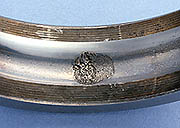
Pitting is another type of failure caused by rolling fatigue, in which minute holes of approx.0.1 mm in depth are generated on the raceway surface.

Damages:
1) Flaking occurring at an incipient stage
- Too small internal clearance
- Improper or insufficient lubricant
- Too much load
- Rust
- Provide proper internal clearance.
- Select proper lubricating method or lubricant.
2) Flaking on one side of radial bearing raceway
- Extraordinarily large axial load
- Fitting between outer ring on the free side and housing should be changed to clearance fit.
3) Symmetrical flaking along circumference of raceway
- Inaccurate housing roundness
- Correct processing accuracy of housing bore. (Especially for split housings, care should be taken to ensure processing accuracy.)
4) Slanted flaking on the radial ball bearing raceway
- Improper mounting
- Shaft deflection
- Inaccuracy of the shaft and housing
- Correct centering.
- Widen bearing internal clearance.
- Correct squareness of shaft or housing shoulder.
5) Flaking occurring near the edge of the raceway or rolling contact surface of roller bearings
- Improper mounting
- Shaft deflection
- Inaccuracy of the shaft and housing
- Correct centering.
- Widen bearing internal clearance.
- Correct squareness of shaft or housing shoulder.
6) Flaking on the raceway surface at the same interval as rolling element spacing
- Heavy impact load during mounting
- A flaw of cylindrical roller bearings or tapered roller bearings caused when they are mounted.
- Rust gathered while out of operation.
- Improve mounting procedure.
- Provide rust prevention treatment before long cessation of operation.
b. Cracking
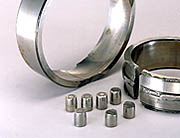
Damages:
1) Cracking in outer ring or inner ring
- Excessive interference
- Excessive fillet on shaft or housing
- Heavy impact load
- Advanced flaking or seizure
- Select proper fit.
- Adjust fillet on the shaft or in the housing to smaller than that of the bearing chamfer dimension.
- Re-examine load conditions.
2) Cracking on rolling elements
- Heavy impact load
- Advanced flaking
- Improve mounting and handling procedure.
- Re-examine load conditions.
3) Cracking on the rib
- Impact on rib during mounting
- Excessive axial impact load
- Improve mounting procedure.
- Re-examine load conditions.
c. Brinelling, nicks
Brinelling is a small surface indentation generated either on the raceway through plastic deformation at the contact point between the raceway and rolling elements, or on the rolling surfaces from insertion of foreign matter, when heavy load is applied while the bearing is stationary or rotating at a low rotation speed.
Nicks are those indentations produced directly by rough handling such as hammering.
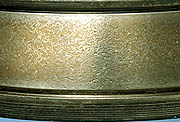
Damages:
1) Brinelling on the raceway or rolling contact surface
- Entry of foreign matter
- Clean bearing and its peripheral parts.
- Improve sealing devices
2) Brinelling on the raceway surface at the same interval as the rolling element spacing
- Impact load during mounting
- Excessive load applied while bearing is stationary
- Improve mounting procedure.
- Improve machine handling.
3) Nicks on the raceway or rolling contact surface
- Careless handling
- Improve mounting and handling procedure.
d. Pear skin, discoloration
Pear skin is a phenomenon in which minute brinell marks cover the entire rolling surface, caused by the insertion of contaminants. This is characterized by loss of luster and a rolling surface that is rough in appearance.
In extreme cases, this is accompanied by discoloration due to heat generation.
Discoloration is a phenomenon in which the surface color changes because of staining or heat generation during rotation.
Color change caused by rust and corrosion is generally separate from this phenomenon.

Damages:
1) Indentation similar to pear skin on the raceway and rolling contact surface.
- Entry of minute foreign matter
- Clean the bearing and its peripheral parts.
- Improve sealing device.
2) Discoloration of the raceway, surface rolling contact surface, rib face, and cage riding land.
- Too small bearing internal clearance
- Improper or insufficient lubricant
- Quality deterioration of lubricant due to aging, etc.
- Provide proper internal clearance.
- Select proper lubricating method or lubricant.
e. Scratch, scuffing
Scratches are relatively shallow marks generated by sliding contact, in the same direction as the sliding. This is not accompanied by apparent melting of material.
Scuffing refers to marks, the surfaces of which are partially melted due to higher contact pressure and therefore a greater heat effect. Generally, scuffing may be regarded as a serious case of scratches.
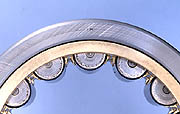
Damages:
1) Scratches on raceway or rolling contact surface
- Insufficient lubricant at initial operation
- Careless handling
- Apply lubricant to the raceway and rolling contact surface when mounting.
- Improve mounting procedure
2) Scuffing on rib face and roller end face
- Improper or insufficient lubricant
- Improper mounting
- Excessive axial load
- Select proper lubricating method or lubricant.
- Correct centering of axial direction.
f. Smearing
Smearing is a phenomenon in which clusters of minute seizures cover the rolling contact surface. Since smearing is caused by high temperature due to friction, the surface of the material usually melts partially; and the smeared surfaces appear very rough in many cases.
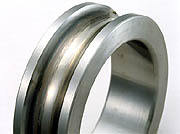
Damages:
1) Smearing on raceway or rolling contact surface
- Improper or insufficient lubricant
- Slipping of the rolling elements This occurs due to the break down of lubricant film when an abnormal self-rotation causes slip of the rolling elements on the raceway
- Select proper lubricating method or lubricant.
- Provide proper preload.
g. Rust, corrosion
Rust is a film of oxides, or hydroxides, or carbonates formed on a metal surface due to chemical reaction.
Corrosion is a phenomenon in which a metal surface is eroded by acid or alkali solutions through chemical reaction (electrochemical
reaction such as chemical combination and battery formation); resulting in oxidation or dissolution. It often occurs when sulfur or chloride contained in the lubricant additives is dissolved at high temperature.
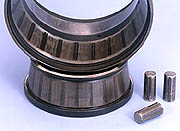
Damages:
1) Rust partially or completely covering the bearing surface.
- Improper storage condition
- Dew formation in atmosphere
- Improve bearing storage conditions.
- Improve sealing devices.
- Provide rust preventive treatment before long cessation of operation.
2) Rust and corrosion at the same interval as rolling element spacing
- Contamination by water or corrosive matter
- Improve sealing devices.
h. Electric pitting
When an electric current passes through a bearing while in operation, it can generate sparks between the raceway and rolling elements through a very thin oil film, resulting in melting of the surface metal in this area. This phenomenon appears to be pitting at first sight. (The resultant flaw is referred to as a pit.) When the pit is magnified, it appears as a hole like a crater, indicating that the material melted when it was sparking. In some cases, the rolling surface becomes corrugated by pitting.
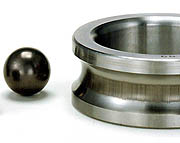
Damages:
1) Pitting or a corrugated surface failure on raceway and rolling contact surface
The bearings must be replaced, if the corrugated texture is found by scratching the surface with a fingernail or if pitting can be observed by visual inspection.
- Sparks generated when electric current passes through bearings
- Providing a bypass, which prevents current from passing through bearings.
- Insulation of bearings.
i. Wear
Normally, wear of bearing is observed on sliding contact surfaces such as roller end faces and rib faces, cage pockets, the guide surface of cages and cage riding lands. Wear is not directly related to material fatigue. Wear caused by foreign matter and corrosion can affect not only sliding surfaces but also rolling surfaces.

Damages:
1) Wear on the contact surfaces (roller end faces, rib faces, cage pockets)
- Improper or insufficient lubricant
- Select proper lubricating method or lubricant.
- Improve sealing device.
- Clean the bearing and its peripheral parts.
2) Wear on raceways and rolling contact surfaces
- Entry of contaminants
- Improper or insufficient lubricant
- Select proper lubricating method or lubricant.
- Improve sealing device.
- Clean the bearing and its peripheral parts.
j. Fretting
Fretting occurs to bearings which are subject to vibration while in stationary condition or which are exposed to minute vibration. It is characterized by rust-colored wear particles. Since fretting on the raceways often appears similar to brinelling, it is sometimes called “false brinelling”.
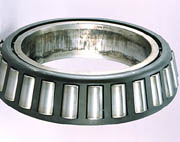
Damages:
1) Rust-colored wear particles generated on the fitting surface (fretting corrosion)
- Insufficient interference
- Provide greater interference.
- Apply lubricant to the fitting surface.
2) Brinelling on the raceway surface at the same interval as rolling element spacing (false brinelling)
- Vibration and oscillation when bearings are stationary.
- Improve fixing method of the shaft and housing.
- Provide preload to bearing.
k. Creeping
Creeping is a phenomenon in which bearing rings move relative to the shaft or housing during operation.
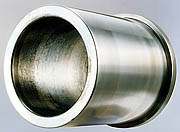
Damages:
1) Wear, discoloration and scuffing, caused by slipping on the fitting surfaces
- Insufficient interference
- Insufficient tightening of sleeve
- Provide greater interference.
- Proper tightening of sleeve.
l. Damage to cage
Since cages are made of low hardness materials, external pressure and contact with other parts can easily produce flaws and distortion. In some causes, these are aggravated and become chipping and cracks. Large chipping and cracks are often accompanied by deformation, which may reduce the accuracy of the cage itself and may hinder the smooth movement of rolling elements.
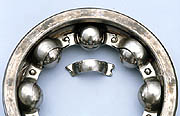
Damages:
1) Flaws, distortion, chipping, cracking and excessive wear in cages. Loose or damaged rivets.
- Extraordinary vibration, impact, moment
- Improper or insufficient lubricant
- Improper mounting (misalignment)
- Dents made during mounting
- Re-examine load conditions.
- Select proper lubricating method or lubricant.
- Minimize mounting deviation.
- Re-examine cage types.
- Improve mounting.
m. Seizure
A phenomenon caused by abnormal heating in bearings.
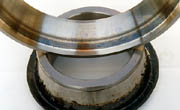
Damages:
1) Discoloration, distortion and melting together
- Too small internal clearance
- Improper or insufficient lubricant
- Excessive load
- Aggravated by other bearing flaws
- Provide proper internal clearance.
- Select proper lubricating method or lubricant.
- Re-examine bearing type.
- Earlier discovery of bearing flaws.

 Exclusive North American distributor for Gamet Bearing.
Exclusive North American distributor for Gamet Bearing.